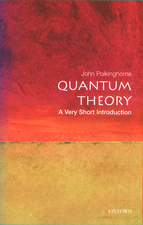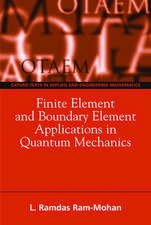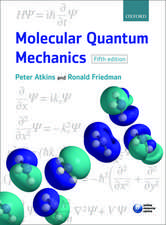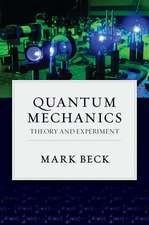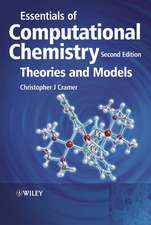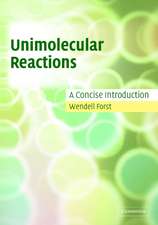Molecular Orbitals and their Energies, Studied by the Semiempirical HAM Method: Lecture Notes in Chemistry, cartea 38
Autor Einar Lindholm, Leif Asbrinken Limba Engleză Paperback – iul 1985
Din seria Lecture Notes in Chemistry
-
 Preț: 96.74 lei
Preț: 96.74 lei - 18%
 Preț: 1123.35 lei
Preț: 1123.35 lei - 18%
 Preț: 776.72 lei
Preț: 776.72 lei - 18%
 Preț: 779.57 lei
Preț: 779.57 lei - 18%
 Preț: 1005.74 lei
Preț: 1005.74 lei - 18%
 Preț: 997.88 lei
Preț: 997.88 lei - 18%
 Preț: 1004.00 lei
Preț: 1004.00 lei - 18%
 Preț: 1136.30 lei
Preț: 1136.30 lei - 18%
 Preț: 1117.03 lei
Preț: 1117.03 lei - 18%
 Preț: 1006.55 lei
Preț: 1006.55 lei - 18%
 Preț: 903.62 lei
Preț: 903.62 lei -
 Preț: 377.73 lei
Preț: 377.73 lei -
 Preț: 395.63 lei
Preț: 395.63 lei - 18%
 Preț: 728.43 lei
Preț: 728.43 lei - 18%
 Preț: 782.57 lei
Preț: 782.57 lei - 18%
 Preț: 1112.78 lei
Preț: 1112.78 lei - 15%
 Preț: 688.13 lei
Preț: 688.13 lei - 15%
 Preț: 646.62 lei
Preț: 646.62 lei -
 Preț: 393.35 lei
Preț: 393.35 lei - 18%
 Preț: 1124.30 lei
Preț: 1124.30 lei -
 Preț: 384.86 lei
Preț: 384.86 lei -
 Preț: 383.71 lei
Preț: 383.71 lei -
 Preț: 378.71 lei
Preț: 378.71 lei -
 Preț: 384.09 lei
Preț: 384.09 lei -
 Preț: 387.42 lei
Preț: 387.42 lei -
 Preț: 388.90 lei
Preț: 388.90 lei -
 Preț: 393.35 lei
Preț: 393.35 lei -
 Preț: 384.09 lei
Preț: 384.09 lei -
 Preț: 377.73 lei
Preț: 377.73 lei -
 Preț: 382.95 lei
Preț: 382.95 lei -
 Preț: 384.70 lei
Preț: 384.70 lei - 15%
 Preț: 644.63 lei
Preț: 644.63 lei -
 Preț: 386.00 lei
Preț: 386.00 lei -
 Preț: 389.70 lei
Preț: 389.70 lei -
 Preț: 384.09 lei
Preț: 384.09 lei -
 Preț: 385.25 lei
Preț: 385.25 lei -
 Preț: 392.21 lei
Preț: 392.21 lei -
 Preț: 386.00 lei
Preț: 386.00 lei -
 Preț: 403.37 lei
Preț: 403.37 lei -
 Preț: 378.71 lei
Preț: 378.71 lei -
 Preț: 383.50 lei
Preț: 383.50 lei -
 Preț: 390.63 lei
Preț: 390.63 lei -
 Preț: 389.31 lei
Preț: 389.31 lei
Preț: 391.02 lei
Nou
Puncte Express: 587
Preț estimativ în valută:
74.82€ • 78.33$ • 61.91£
74.82€ • 78.33$ • 61.91£
Carte tipărită la comandă
Livrare economică 07-21 aprilie
Preluare comenzi: 021 569.72.76
Specificații
ISBN-13: 9783540156598
ISBN-10: 3540156593
Pagini: 304
Ilustrații: X, 290 p.
Dimensiuni: 170 x 244 x 16 mm
Greutate: 0.49 kg
Editura: Springer Berlin, Heidelberg
Colecția Springer
Seria Lecture Notes in Chemistry
Locul publicării:Berlin, Heidelberg, Germany
ISBN-10: 3540156593
Pagini: 304
Ilustrații: X, 290 p.
Dimensiuni: 170 x 244 x 16 mm
Greutate: 0.49 kg
Editura: Springer Berlin, Heidelberg
Colecția Springer
Seria Lecture Notes in Chemistry
Locul publicării:Berlin, Heidelberg, Germany
Public țintă
GraduateCuprins
A. The LCAO model: “LCAO”.- 1. Molecular Orbitals ??.- 2. The LCAO formalism.- 3. The normalization and orthogonality of orbitals.- 4. How to interpret the print-out from a calculation.- 5. The charge in ? ?.- 6. The charges on atoms and in bonds.- 7. The idempotency of density matrices.- B. Hartree-Fock total energy: “HF”.- 1. The Hamilton operator.- 2. The wavefunctions in Hartree-Fock theory.- 3. The total energy in Hartree-Fock theory.- 4. The total energy in LCAO Hartree-Fock theory.- 5. Self-repulsion.- C. Density functional theory: “Density functional theory”.- 1. Correlation.- 2. Correlation energy.- 3. Exact energy expression.- 4. Exchange-correlation energy.- 5. Density functional theory: Kohn-Sham orbitals.- 6. Introducing Kohn-Sham orbitals.- 7. Introducing LCAO.- 8. Pair-correlation energies.- 9. Semiempirical methods.- 10. Comment on semiempirical theories.- 11. Conventional CI method to handle correlation.- 12. Proof for Gunnarsson-Lundqvist Exc.- D. Total energy of molecules and atoms: “HAM”.- 1. Rearrangement of the total energy expression.- 2. Shielding efficiencies ??? in the one-center terms.- 3. The one-center energies in a molecule.- 4. Further study of the shielding efficiencies.- E. Atoms: “Atoms”.- 1. The simple atom.- 2. The energies of the spin-configurations.- 3. Comments on the shielding efficiencies.- 4. Previous work on shielding efficiencies.- 5. Total energies of atoms and atomic ions in HAM/3.- 6. The multiplet split in atomic spectroscopy.- 7. The average state.- 8. Energies of terms — energies of average states.- 9. The physical meaning of the parameters.- 10. The semiempirical methods HAM/3 and HAM/4.- F. Molecules: “Molecules”.- 1. Interpretation of the energy expression for a molecule.- 2. Localdipoles.- 3. The final expression for the total energy.- 4. The parametrization of HAM/3.- G. Solving the Schrödinger equation: “SCF”.- 1. Variational calculus.- 2. Deduction of Roothaan’s equations.- 3. The Fock matrix elements.- 4. Solving the Roothaan equations.- 5. Some useful relations for the eigenvalue.- 6. Comparison with the Hartree-Fock method.- 7. The eigenvalue ?? in Hartree-Fock and HAM.- 8. Molecules with a small HOMO-LUMO gap.- H. Ionization and photoelectron spectroscopy: “PES”.- 1. Calculation of ionization energy in the HAM model.- 2. Treatment of ionization energies in Hartree-Fock.- 3. Calculation of ionization energies in ab-initio work.- 4. Experimental methods for study of ionization.- 5. Ionization of molecules: some results.- 6. Further studies.- I. Excitation and UV spectroscopy: “UV”.- 1. Calculation of excitation energy in the HAM model.- 2. A primitive CI method to find singlet-triplet splitting.- 3. Calculation of intensitites.- 4. Semiempirical methods to calculate excitation.- 5. Rydberg transitions.- 6. Calculation of excitation energies in ab-initio work.- 7. Experimental methods for study of excitation.- 8. Excitation of molecules: some results.- 9. Degenerate excited configurations will interact: CI.- 10. Excitation of linear molecules.- J. Negative ions and electron affinities: “EA”.- 1. Calculation of electron affinities in the HAM model.- 2. Experimental methods for determination of EA’s.- 3. Electron affinities of molecules: some results.- 4. The relation between the PES, UV and EA results.- 5. Other calculations of electron affinities.- 6. ?* orbitals.- K. Studies of 1s electrons: “ESCA”.- 1. Calculation of 1s ionization energies in the HAM model.- 2. Experimental methods in ESCA.- 3. ESCA energies:some results.- 4. Excitation of 1s electrons, studied in electron impact.- 5. Excitation of 1s electrons, studied spectroscopically.- L. Shake up in PES and EA: “Shake up”.- 1. Shake up in PES.- 2. Calculation of the PES shake-up energy.- 3. Shake ups in PES: some results.- 4. Discussion of calculations of shake up in PES.- 5. Shake up in EA.- 6. Shake ups in EA in small molecules: some results.- 7. The UV spectrum of the naphthalene anion.- 8. Shake ups in EA in larger molecules.- M. Total energy: “Total energy”.- 1. The total energy of a molecule.- 2. Heat of formation.- 3. Check of the transition state method.- 4. Doubly charged ions.- N. Dipole moments: “Dipole moment”.- 1. Calculation of dipole moment.- 2. Dipole moment of HCN.- O. Chemical reactions: “Reactions”.- 1. Can a HAM model be used?.- 2. Dissociation of cyclobutane.- 3. The internal rotation of ethylene.


